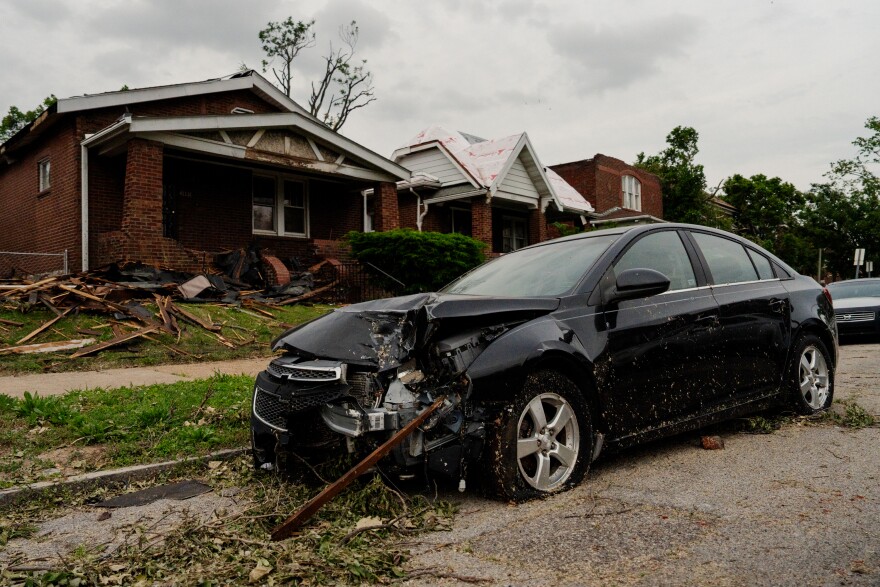St. Louis Mayor Cara Spencer created a 15-member committee to help its Office of Recovery shape the immediate tornado repair needs and execute them with thoughtful community input.
During its meeting on Wednesday, the Tornado Recovery Advisory Committee focused on short-term solutions for winter shelter, case management, creating resource hubs, identifying funding gaps and winter outreach.
“This effort is too big for the city to solve, but we also recognize we've lacked the coordination with the groups on the ground and with all of us more broadly to actually drive that collective effort,” said Julian Nicks, St. Louis’ chief recovery officer. “We're excited to have this committee finally here to … figure out how we drive better planning, how do we think and drive our collective resources to drive impact, and how do we make sure we're moving toward immediate action.”
Over the next month and a half, the group’s immediate plans are to help the city increase shelter capacity and establish a shared data and communication system to support the city’s winter readiness plan.
The tornado recovery committee comprises north St. Louis residents and business owners, as well as leaders from church and community organizations in zones impacted by the tornado. The city also selected 41 more members to form neighborhood planning committees within impact zones. They will work with the tornado recovery committee to ensure all information is passed along throughout various neighborhoods and community organizations.
During the working meeting, the recovery committee identified some major barriers community organizations faced when trying to access funds, including restricted funding, administrative burdens, staffing shortages and Federal Emergency Management Agency compliance requirements. However, organizations are finding assistance through foundation gap funding, credit unions and foundation funds.
“Many of the funders share that they want to get resources directly to residents as quickly as possible, and then fully fund rental assistance needs,” said Erica Henderson, founder of Key Strategic Group and a committee facilitator. “There are a few programs that are ready to be launched, and so making sure that there is adequate information for those and they're able to move through them as quickly as possible by getting that information out to residents.”
Leaders also discussed the lack of hotel rooms, apartments, dorms and shelters ready to accept families, which is a foundational issue the group is working to address over the next month. Some reasons why living spaces are not readily available include liability concerns, slow contracting services with the city and staffing issues.
“The impact goals that were highlighted were a need really for 400 congregate beds to be ready by the middle of December, and 600 non-congregate beds to be secured within that same time frame,” said Rebeccah Bennett, founder of Emerging Wisdom LLC and a meeting facilitator. “The solutions that were elevated were expanding hotel and apartment partnerships, standing up more congregate sites using a standard staffing and training model that allows us to maximize efficiency and capacity.”
Some community organization leaders, like Michael McMillan of the Urban League of Metropolitan St. Louis, and a member of the Spirit of St. Louis Task Force, added that they would be willing to help in any capacity with shelter needs.
The Rev. Linden Bowie of Zion Traveler’s Missionary Baptist Church in Riverview suggested the city tap into resources outside of the city limits to help with winter shelter needs.
“If all we're thinking about is within the city limits proper, we may be missing out on a number of resources and opportunities. I know that our church has a gymnasium that we’ll be opening up to make beds available,” Bowie said. “I think that some consideration ought to be given to how we're going to maximize the regional approach versus, you know, simply a city approach.”
Committee members also want to expand the support system to help streamline the services for residents and providers. They say the lack of a unified navigation system and a single point of contact causes delays in deploying case managers and referrals. To help remedy this, the committee plans to streamline the case management system and create a community care hub that will be operational by January.
“We know that in an effort to get any of the 2,700 homes that are impacted, we need to ramp up staff quickly over the next 45 days to ensure that we are able to share all of the information available to them,” said Henderson.
Henderson said it will take the entire community to help rebuild north St. Louis, including community organizations, because they already have a network to help disseminate information across neighborhoods and partners.
The winter season is a major concern for committee members. They say some residents remain in damaged homes with unsafe heating and are in need of stable, safe winter housing options.
To prioritize winter readiness, they plan to update the website, print packets with clear resources, deploy coordinated door-to-door outreach using community health workers and trusted community partners and build a shared survey for consistent data collection.
“There’s more than 2,700 residents that may be living in unstable structures. We've seen that some folks have moved to shelters, some have gone to hotels, some are couch surfing, so we want to make sure that we are sharing all of the available resources that are present,” Henderson said. “The city is … reaching out to landlords for vacant unit turns and listing available properties that people can get connected to.”





